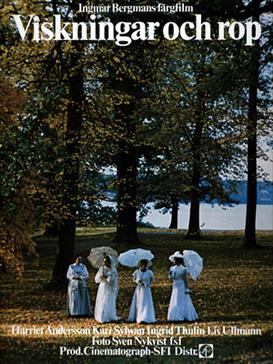Pages
▼
Thursday, March 17, 2016
Cries and Whispers (Ingmar Bergman, 1972)
Cries and Whispers is both of a time and timeless. It is very much a product of the last great moviegoing age, when people would see a challenging film and go back to their homes or coffee shops or dorm rooms and debate what it meant. Today, if a movie provokes discussion it's usually on social media, where seriousness gets short shrift. Moreover, the discussion is likely to get interrupted by someone who has just seen the latest installment of some hot TV series and wants to try out their theories. Moreover, the combination of visual beauty and emotional rawness in Bergman's film is something rarely encountered today. We are, I think, wary of emotion, too eager to lapse into ironic distancing from the depiction of disease, suffering, death, cruelty, passion, spite, and grief that permeates Cries and Whispers. No director I know of is trying to do what Bergman does in so unembarrassed a fashion in this movie. And that, in turn, is what makes it timeless: The emotions on view in the film are universal, and Bergman's treatment of them without melodrama or sentiment is unequaled. Personal filmmaking is becoming a lost art: There are a few prominent adherents to it today, such as Paul Thomas Anderson or Terrence Malick, and their films are usually greeted with a sharp division of opinion between critics who find them pretentiously self-indulgent and those who find them audaciously original. But we seldom see performances as daring as Harriet Andersson's death scene, Kari Sylwan's attempts to comfort her, Ingrid Thulin's self-mutilation, and Liv Ullmann's confrontations with the others. And we seldom see them in a narrative that teeters between realism and nightmare as effectively as Bergman's screenplay, in a setting so evocative as production designer Marik Vos-Lundh's, or via such sensitive camerawork as Sven Nykvist's. The film has often been compared to Chekhov, and for once it's a film that merits the comparison.
Charles Matthews
